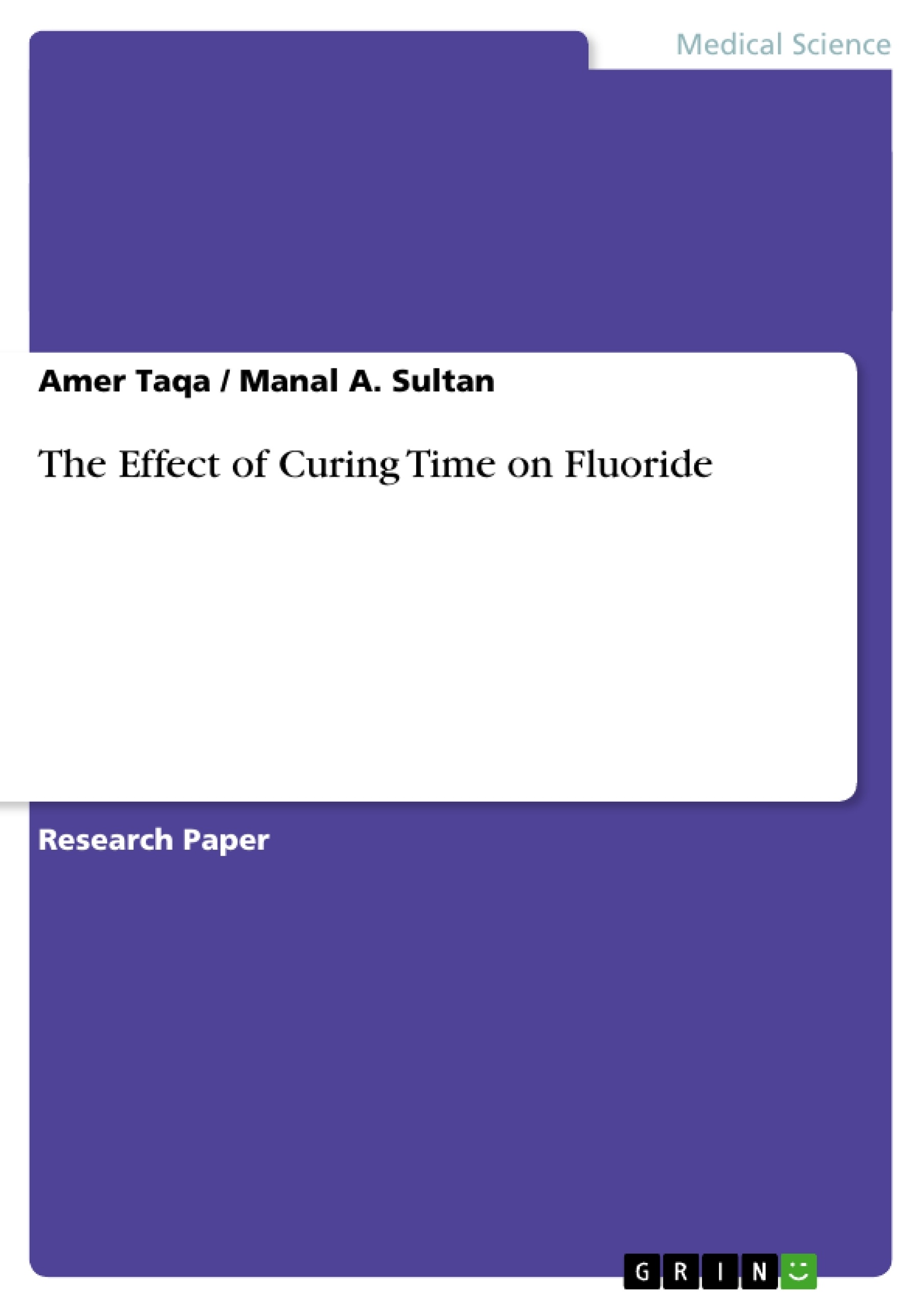Aim: This study aims to measure the amount of fluoride release in deionized water from two composite resins materials (Kerr and Tetric ceram)over period of one month. By using different curing time for curing the composite.Materials and Methods : Two types of composite resin materials were used.
They are Tetric ceram and Kerr composite resins divided into five groups for each type of materials used, each group contain ten sample materials and cured with different time of curing which are (20,30,40,50,60) seconds.The samples measured fluoride release after storing in 5ml of deionized water then incubated incubator at 37°C for 24 hours.Results: The amount of fluoride release was affected by the period of curing time. The materials which cured at (20,30,40) seconds gave high amount of fluoride release while the materials which cured at (50,60)seconds gave low amount of fluoride release.
Conclusions: The amount of fluoride release from composite resins materials were affected by curing time. There is an increase in the amount of fluoride release by decreasing the period of curing time and decreasing by increasing the period of curing time.
ABSTRACT
Aim: This study aims to measure the amount of fluoride release in deionized water from two composite resins materials (Kerr and Tetric ceram)over period of one month. By using different curing time for curing the composite.Materials and Methods : Two types of composite resin materials were used. They are Tetric ceram and Kerr composite resins divided into five groups for each type of materials used, each group contain ten sample materials and cured with different time of curing which are( 20,30,40,50,60) seconds.The samples measured fluoride release after storing in 5ml of deionized water then incubated incubator at 37C for 24 hours.Results: The amount of fluoride release was affected by the period of curing time. The materials which cured at (20,30,40) seconds gave high amount of fluoride release while the materials which cured at (50,60)seconds gave low amount of fluoride release. Conclusions: The amount of fluoride release from composite resins materials were affected by curing time. There is an increase in the amount of fluoride release by decreasing the period of curing time and decreasing by increasing the period of curing time. Key words: Curing time, fluoride release, composite resin.
Abbildung in dieser Leseprobe nicht enthalten
INTRODUCTION
Fluoride is an effect cariostatic agent many dental materials have been designed to provide fluoride to the oral environment (1).
According to the current understand- ing restorative materials that slowly re- lease fluoride extra local cariostatic effect 2 3 not only the secondary caries be reduced at restoration margins, but adjacent teeth are also believe to be benefit from constant fluoride release 4.
Thus they function in accord with the major cariostatic mechanism of fluoride, which is believed to be its action to promote remineralization and to influence the morphology of teeth by reducing enamel solubility and by suppressing oral cariogenic bacteria 5.
Dental composites consisting of a polymerizable resin matrix, reinforcing glass particle filler and saline coupling agents are becoming more popular in modern dentistry6. These glass practical resin matrix composites have good a esthetic properties and strength making them the most widely used materials for restorations of anterior teeth7.
The polymariozable resin matrix typically contains one or more monomer such as ethleneglycol dimetha crylate (Bis-GMA), Urethan edimeth crylate (UDMA) and triethylen eglycol dimetha crylate (TEGDMA). The strength of a restorative material is an important parameter in relation to the liability of fracture of restoration under occlusal load 8.
High initial strength is important and it is desirable that a material maintain its strength over time in an aqueous environment it has been found that resin composite and poly acid-modified resin composites either maintain mechanical properties or suffer a reduction in strength and hardness, depending on brand of material and testing conditions9.
Regarding polyacid- modified resin composites, the under lying rationale is based on the idea that as water from saliva diffuses in to the material, the carboxylic acid groups of the polymer will release hydrogen ions. These hydrogen ions then attack the fluoride containing filler parti- cles. This mean that although initially small, the release of fluoride may become of substantial magnitude after a certain period of time in an aqueous environ- ment(10).
The development of new photo acti- vation methods raised the concern that low curing rates may alter the final structure of the polymer and negatively affect the ma- terial’s chemical and physical properties, in spite of reaching degrees of conversion similar to the reached with the use of con- tinues high intensity photo activation (11).
[...]
1. Tumba KJ, Curzon MEJ (1993). Slow release fluoride. Caries Res 27(suppl 1): 43-46.
2. Willams P. Good by amalgam, hello alternative? J Can Dent Assoc 1996; 62:139-44.
3. Hse K M, Leung SK, Wei SH, Resin-ionomer restorative materials for children: A review Aust J Dent 1999; 44:1-11.
4. Donly KJ, Nelson JJ. Fluoride release of restorative materials exposed to a fluorideated dentifrice. ASDC J Dent child 1997;64:249-50.
5. Attin T, A.M. Kielbassa, S. plogman, Eltellwig. Fluoride release from compomer in the acidic and netural environment, Dtsch Zahnarztl. Z51(1996); 675-678.
6. Ferracane JL. Current trends in dental composites crit Rev Oral Bio Med 1995; 6:302-18.
7. Nicholson JW. Adhesive dental materials and their durability. Inter J Adhes 2000; 201:11-16.
8. Fracci C, Deaton JG, Arnold RR, Swift EJ, Perdigao J, Baeden JW, etal. Fluoride release from restorative materials and its effects on dentin demineralization. J Dent Res 1999; 78:1647-54.
9. Asmussen E, Pentz feldt A. Long-termfluoride release from glass ionomer cement, a compomer, and from experimental resin composites. Acta Odonto Scand 2002; 60:93-7.
10. Musanjie L, Darvell BW. (2003): Polymerization of resin composite restorative materials: exposure reciprocity. Dent Mater; 19:531-541.
11. Halvorson RH, Erickson RL, Davidson CL. (2003): The effect of filler and silane content on conversion of resin-based composite. Dent Mater; 19:327-333.
- Citation du texte
- Amer Taqa (Auteur), Manal A. Sultan (Auteur), 2008, The Effect of Curing Time on Fluoride, Munich, GRIN Verlag, https://www.grin.com/document/209001




